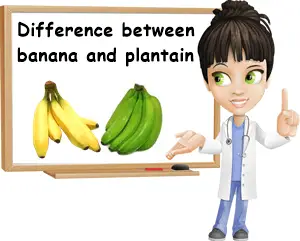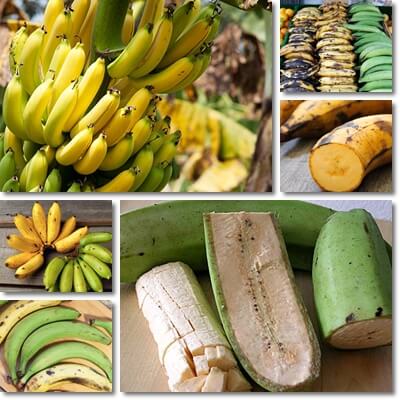Bananas and plantains are essentially the same fruit, but not quite the same. The number one difference between them is that bananas have more sugar and a sweeter taste and are eaten raw, while plantains have more starch and less sugar and are eaten cooked. This variation in starch-sugar content determines the difference in taste between bananas and plantains as well as the ripening stage they are best enjoyed at. For example, bananas are usually eaten ripe while plantains are often eaten unripe, but always cooked. But despite the many differences between them, the two fruit also share several characteristics and properties, rendering a distinction difficult, especially for the cultivated varieties that are neither fully a banana nor a plantain.
In order to best understand the difference between bananas and plantains, it helps to know what they are and how they’ve come to be what they are. Here are some key facts about the fruit:
1) Modern bananas and plantains are both hybrid fruits, evolved from two ancestor banana species, Musa acuminata and Musa balbisiana.
2) Bananas and plantains also share a botanical name: Musa paradisiaca. This means they are essentially the same fruit species or, better said, variations of the same fruit.
3) Both can be eaten raw when ripe and cooked at any ripening stage.

4) Unripe plantains and less sweet dessert bananas are classified as cooking bananas.
5) Both bananas and plantains are green when unripe and most will be yellow at some point in the ripening process.
6) Bananas and plantains are harvested while green and continue to ripen afterwards, given enough time.
7) Both bananas and plantains contain starch which is converted into sugar as they ripen.
What is the difference between bananas and plantains?
As variations of the same fruit, the following distinctions can be made:
1) Bananas have a higher sugar content which gives them a sweeter taste. This makes them more suitable for eating raw (always ripe) and are, as a result, called dessert bananas.
2) Plantains have a higher starch content which gives them a less sweet taste. This makes them more suitable for eating cooked (usually unripe) and, as a result, are called cooking bananas.
3) The reason why bananas are preferred ripe is because the ripening process converts the starch into sugar and makes them sweeter and softer in texture. The reason why plantains are preferred unripe is because this stage is when they have the most starch content and starch is what makes them suitable for cooking.
4) Desert bananas are regarded as a culinary fruit, while plantains are regarded as a culinary vegetable. Although they are both being used in the most diverse preparations, in the most imaginative ways.
5) Plantains go from green when unripe to yellow when ripe, then black when overripe. Most bananas are green when unripe and golden yellow when ripe, sometimes with brown speckles or spots or black blotches when overripe. Some dessert bananas are red, purple and brown when ripe.
6) Plantains have a thicker skin that is difficult to peel by hand when still unripe. Bananas have a thinner peel that can be pulled apart by hand at any ripening stage.
7) Plantains are generally bigger than bananas.
8) Overripe plantains can sometimes be sweeter and tastier than desert bananas.
9) Unripe plantains have a tough texture and taste starchy and bland like potatoes when raw and like cooked potatoes when cooked. Unripe bananas have a firm texture, but you can easily bite into them and taste somewhat bland, with mild banana and green flavors and a faint banana smell.
10) Ripe plantains are sweet, but somewhat starchy, with a firm texture. Overripe ones (black peel with yellow blotches) can be extremely flavorful, although not always as sweet as ripe bananas, while their texture ranges from firm to soft, depending on how overripe they are. Ripe and very ripe bananas are honey-sweet, with a firm and soft pulp and a strong banana smell to them. Overripe bananas are almost mushy, sweet-alcoholic in taste with fruity flavors and a fermented fruit perfume to them.
11) Plantains are 65% water, while bananas are 75% water, hence the difference in texture.

Bananas vs plantains: nutrition and major health benefits
1) Ripe bananas with golden peel and brown or black speckles are a great food to eat for gastritis because of their soft texture and composition which doesn’t disrupt digestion in any way. Anything before the uniform golden peel and brown speckles is not good to eat for gastritis.
2) Plantains can be both good and bad for the stomach. Ideally, they should be either overripe or cooked without too much oil, butter or spices. Eating unripe, green and barely yellow plantains (or bananas) or plantains cooked with too much fat or spices is not good for gastritis and is likely to give you a stomach ache.
3) Plantains and bananas are good sources of potassium and help regulate blood pressure. 100 g of plantain has 499 mg of potassium, while 100 g of banana has 358 mg of potassium. Regular intake may provide benefits for arrhythmia, extrasystoles and palpitations (read more about the Properties and Benefits of Plantains and Properties and Benefits of Bananas).
4) Bananas and plantains are great foods to eat if you have hemorrhoids or suffer from constipation because they are good sources of dietary fiber, regulating transit time and promoting soft stools that are easy to pass.
5) Both contain moderate amounts of magnesium and help prevent muscle weakness and muscle spasms, cramps, tremors and twitching. Bananas have 27 mg of magnesium/100 g, while plantains have 37 mg of magnesium/100 g.
6) They contain vitamins B1, B2, B3, B5, B6 and B9 and contribute to better energy levels, good digestion and healthier skin as well as help produce neurotransmitters in the brain which promote better mood. Bananas have around 8% more vitamin B6 than plantains.
7) Plantains have more vitamin C than bananas (18.4 mg vs 8.7 mg) and provide antioxidant, anti-inflammatory and immune-boosting benefits.
8) Both are low in protein, sodium, vitamin A, zinc and other minerals and have no cholesterol, less than 0.4 g of fat/100 g, no vitamin D and almost no vitamins E and K.
9) Plantains have 122 kcal per 100 g and almost 32 g of carbohydrates, while bananas have 89 kcal per 100 g and almost 23 g of carbohydrates, helping maintain a steady weight and providing quick energy for the body to use. Overall, despite the differences between the two, from a nutritional standpoint, bananas and plantains are quite similar and provide similar health benefits.
